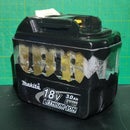Introduction: Paracord & 3D Printed Key Protector
Having just bought my first car, my only set of keys was looking rather bare, although the keys/multi-tools that I did have presented the issue of scratching anything else in my pocket (Phone cases, bank cards, my hand... etc). I also like to drive distraction-free, so this seemed like a great way to eliminate the clinking noises they made as well.
The only similar thing I could find already available for purchase were "key organisers", but organising keys seems kind of pointless when you only have one (Not including the car key), besides, they were all made from metal anyway.
This left only one option... DIY!
Step 1: Designing the Plastic Skeleton (Not Spooky!)
This is essentially a hollow reinforcing block to provide a rigid frame to wrap the paracord around. Using paracord alone would cause the weaves to slip off due to the lack of tension (A gap would need to be left to insert the key) and the key would snag on the paracord). This plastic block could be used by itself, but paracord has more of a military feel to it and provides a way to secure the protector with a loop.
I used Blender to design the plastic housing, starting with two basic cubes, elongating them and giving them some stylish bevelled edges. From a previous paracord bracelet I had made, I determined that the loops repeated every 8.2mm, so I created some notches every 4.2mm (Each loop requires an "in" and an "out" notch) to prevent the paracord slipping off the end. To verify the model was suitable for printing I passed it through Microsoft's model repair service before setting it up for printing. The dimensions are 51mm by 27mm by 7.5mm.
Not many people currently have a 3D printer, although this step could easily be replicated using 1mm plastic for the top and bottom plates, and an outline of the key traced onto 3mm MDF and bounded by a rectangular box. The entire thing could probably also be made from multiple layers of cereal box card reinforced with wood glue!
If your key has trouble fitting inside the 3D printed cavity after filing away the support material, place the 3D part in a small amount of boiling water for around 10 seconds. It should be hot enough to allow you to force the key in and deform the plastic slightly to provide a better fit without actually melting it.
The file is available for download here
(9/4/16) Updated version with integrated 3mm holes here
Step 2: Wrapping the Paracord
The style of the paracord weave is up to you, although the "cobra" stitch lends itself nicely to this design as it doesn't add too much extra bulk to the overall size.
To simplify adding a loop to one end (To reduce the chance of losing the key fob) I drilled two small holes (Approx 3mm diameter) so the paracord would barely fit through and would resist loosening. Squeezing/pulling the outer sheath along the paracord's core helps make the end thinner, and easier to fit through the hole, allowing you to pull the rest (Sheath and core together) through.
Plenty of tutorials exist on how to wrap paracord, but the basis is that you alternate the direction of the cord each time you thread it through the cord on the other side. To reduce wasted cord, I don't cut the cord until I've finished the weave. This makes weaving more cumbersome, but it's preferable to underestimating the length of cord and having to start over!
Step 3: Terminating the Cords
Use a sharp knife to cut the paracord around 3mm from the neighbouring cords. Hold a flame perpendicular to the end of the cord so that it's barely touching the frayed ends, and melt it back 1-2mm (Try not to let it melt the other cords). As soon as possible, press a flat piece of metal against the melted end to flatten it to the same level as the adjacent cords.
This widens the end, and partially melts it to the other cords, meaning it shouldn't come loose unless it's deliberately pulled out.
Step 4: Finished!
Simply hook the paracord loop onto your keyring and you're done!

Participated in the
Hack Your Day Contest











